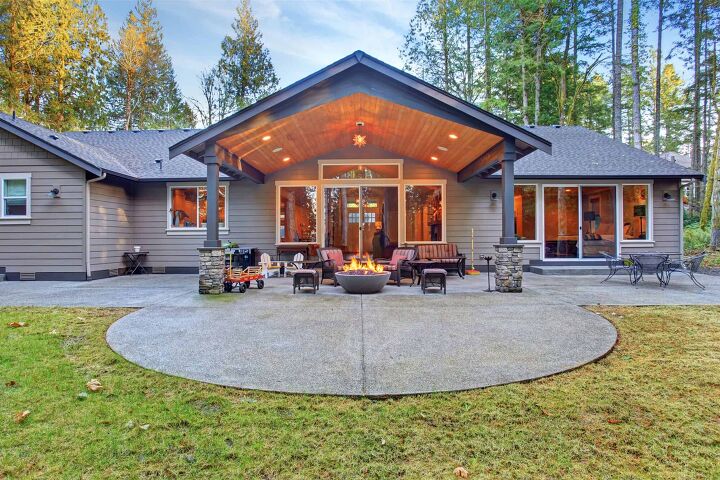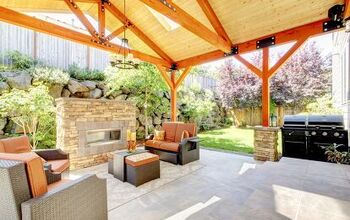How To Attach A Ledger Board For A Patio Cover

Patios are a great opportunity to extend the aesthetic and feel of your home to the outside while adding space. Outdoor spaces, such as patios, add value to a home, but they also are exposed to the elements which can do them harm. Because of that, many homeowners choose to install a patio cover over their patio to protect it and add visual flair.
Before you can install a patio cover, you must attach a ledger board to the house. Ledger boards support patio covers as they are installed using the house’s frame. Install the ledger board under the eaves of the house where the roof hangs over or in the rim joist between the floors of the house.
Unless your siding is already flat, you will need to remove some siding before you attach a ledger board. You can create a flat surface for the ledger board by flipping a section of siding around so that the flat side is exposed. Cut into the wall, attach the ledger board to the rim joists and nail it to the studs.
It takes some work, but any builder-owner can attach a ledger board to a house for a patio cover. Follow along as we explore the installation step by step.
What Is a Ledger Board?
A ledger board essentially serves as a base for the actual patio cover when it is time to install it. Ledger boards are as supportive as they are because they are directly connected to the house’s frame. Patio cover ledger boards vary in size but are often 2’ x 6’.
You cannot install a patio cover to a structure that is already standing without attaching a ledger board to the house first. If your ledger board is level and secured to the house framing using screws or bolts, it is ready for a patio cover to go on.
How To Install Ledger Board To House
You can attach a ledger board to a house for a patio cover easily, but it takes a little time. Before you do anything, you must gather the necessary materials, such as:
- A circular saw
- Drill
- Ladder
- Ledger board (2’ x 6’)
- Lag screws/bolts
- Nails
It is important that you install a ledger board with the help of at least one other person. The materials can be cumbersome, plus, you should always have a spotter anytime that you work with ladders. Also, be sure to plan out exactly how high up you want to attach your ledger board to your house.
How high you place your ledger board determines the height of the patio cover itself. Once you have all of the tools and materials, you can get started.
1. Choose the Location
How big is your house? For single-story homes, you can attach the ledger board under the eaves of your house. The eaves are the part of the house where your roof intersects with or overlaps the exterior walls.
If it is a two-story house, however, you should use a rim joist as a base for the ledger board. The rim joist is the joist closest to the exterior wall material and can be reached by removing the material, i.e., siding. Rim joists sit between the first and second floor of the house.
2. Prepare the Siding
Your siding may need preparation before you can attach a ledger board to the house. If your siding is not smooth, you should remove it in the spot where the ledger board is going. Rougher siding, like vinyl, or beveled wood, is not smooth or flat enough for a ledger board.
Remove the siding using a siding removal tool if it is rough or beveled. Otherwise, you can screw the 2’ x 6’ ledger directly to the house through the siding for a one-story home.
How To Remove SidingIf it is just vinyl siding, use a removal tool, which you can find for $6-$15, and remove only as much as the size of the ledger board. Beveled wood siding, however, is trickier to remove.
You can remove beveled wood siding using a circular saw to expose the rim joist. You may not always need to use a circular saw, but it is a good idea to have one on hand. The rim joist is a part of the house’s framing, so it is much more supportive than a rough, coarse, siding surface.
However, if you do use a circular saw, be extremely careful so that you don’t cut too deep. If you cut into the house’s sheathing directly, it won’t support the ledger board.
3. Attach Ledger Board To House
Now, it is time to actually attach the ledger board to your house. Your best bet to ensure a sturdy fit is lag screws. Lag screws, or lag bolts, have a reputation for being particularly tough, unmoving, and durable.
If at all possible, attempt to locate wall studs to screw into, particularly for one-story homes. Whether attaching directly to siding or to the rim joist, use your power drill to fasten the lag screws. Attach washers to the lag screws after they are in place to further fortify the ledger board.
4. Add Flashing To Ledger Board
Flashing, aluminum flashing in particular, can save you the heartache of water damage. Place aluminum flashing behind the siding between the siding and the wall beneath it. After you place your flashing, seal the top of it with caulking, and hammer several nails into it.
After you hammer the nails into the flashing, caulk the very tops of each one nail. You may not be able to hide all of the flashing under the siding, and that is okay. If you have a one-story house, see if the excess aluminum flashing can be tucked up to the eaves above the ledger board.
How Much Do Patio Covers Cost?
If you hire a professional, a patio cover can cost between $1,400 and $10,000, or more, depending on materials. However, the vast majority of that cost is made up of labor. You can find several DIY patio cover bundles that cost $1,600-$2,400.
Because of that and the relative ease of installation, many builder owners install their own ledger board and patio cover. You can save up to $8,000 or more in labor costs by installing a patio cover on your own.
Summing It Up
You can attach a ledger board to a house for a patio cover by fastening it to the framing through the siding, or the rim joist. A rim joist is your best bet as it is quite secure but is only possible for two-story houses. Otherwise, for one story homes, try to fasten the nails securing the ledger board directly into wall studs.
It is a great idea to install flashing underneath the siding after attaching a ledger board. Aluminum flashing, in particular, can prevent water from leaking behind it and damaging the siding, or even worse, the wood. Try to have one other person with you to assist with removing siding and spot you on the ladder.
Good luck attaching a ledger board to your house, and surely it will support your patio cover.
Related Guides

Nick Durante is a professional writer with a primary focus on home improvement. When he is not writing about home improvement or taking on projects around the house, he likes to read and create art. He is always looking towards the newest trends in home improvement.
More by Nick Durante


























![Standard Dining Room Table Dimensions [for 4, 6, 8, 10 and 12 People]](https://cdn-fastly.upgradedhome.com/media/2023/07/31/9074335/standard-dining-room-table-dimensions-for-4-6-8-10-and-12-people.jpg?size=350x220)
